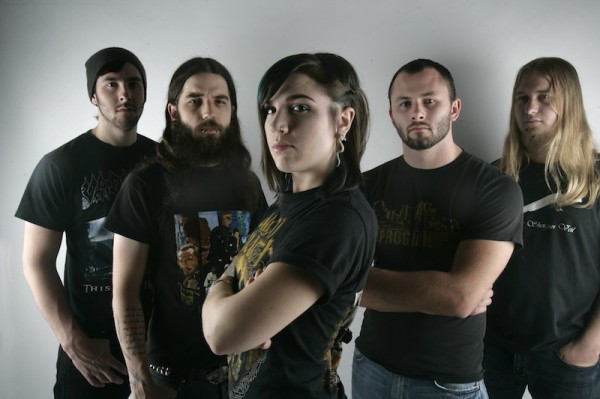
(Andy Synn returns with his 17th edition of THE SYNN REPORT and a look-back at the discography of the late, lamented Light This City. Of course, we’re streaming songs from the albums, too.)
Now sadly deceased, Light This City were shaping up to be prime movers and shakers in America’s metal scene before their unfortunate dissolution. With a back-catalogue of four albums of thrashing, raging, melodic death metal, the 5-piece, fronted by human whirlwind Laura Nichol, took the Gothenburg sound and moulded it into something distinctively American, without falling into the rut of metalcore imitation, becoming darlings of the underground scene in their short time together.
One of the strongest comparisons that can be made of the Californian quintet, in the most positive sense, is of a less dark, more thrashy variant of The Black Dahlia Murder’s specifically American brand of melodic death metal, with the latter’s scalpel-sharp Dissection influence replaced with a stronger focus on flowing At The Gates melodicism and chunky Bay Area guitar rhythms, accented by forays into explosive blast beats, soaring Maiden-esque leads and heroic displays of guitar pyrotechnics.
Frontwoman Laura Nichol possesses a powerful voice that shifts organically from a blackened, wounded screech to a rumbling, guttural growl redolent with primal ferocity and sheer, overwhelming presence. The guitars, primarily stemming from the mind and fingers of band co-founder (and drummer) Ben Murray – who switched purely to drums after the band’s second album, allowing new-found guitar wunderkind Brian Forbes to step forward – thrash out a hurricane of molten, distorted riffs and blazing guitar leads, matching their soaring melodies and shredding solos with a crushing delivery of down-tuned devastation.
Although the band are unfortunately no more, they left behind them an enviable legacy of instrumental talent and impressive compositional skill. With a laser sharp focus and a tightly co-ordinated line-up, the group were able to take their influences, many of which have since become standard fare for today’s less-inspired metal groups, and meld them into something wholly individual, using their influences to achieve something greater for themselves; re-interpretation, rather than rote imitation. (more after the jump . . .)
The Hero Cycle – 2003
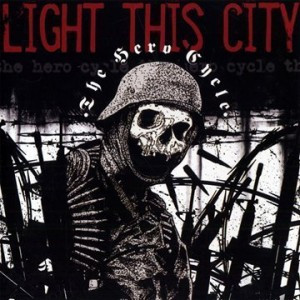 Perhaps more of an intriguing curiosity these days than a striking statement of intent, The Hero Cycle displays only the barest glimmers of the melodic death metal juggernaut the band would eventually become. Notably more primitive than the albums which would follow it, Light This City’s first record is more unashamed in its tribute to the Gothenburg scene, with less of the culturally specific American flavours that, in later years, would allow them to develop their sound in more varied and – ultimately – more potent and individual ways.
Perhaps more of an intriguing curiosity these days than a striking statement of intent, The Hero Cycle displays only the barest glimmers of the melodic death metal juggernaut the band would eventually become. Notably more primitive than the albums which would follow it, Light This City’s first record is more unashamed in its tribute to the Gothenburg scene, with less of the culturally specific American flavours that, in later years, would allow them to develop their sound in more varied and – ultimately – more potent and individual ways.
Opening with the fuzzy distortion of “Apostate”, the band dive straight into a full-on Gothenburg riff which, although somewhat overly familiar, progresses pleasingly throughout the song, appearing in multiple incarnations, each delivered with vibrant enthusiasm, and provides the song with a strong keystone, cut and carved perfectly to support the song’s metallic foundations.
“Picture: Start” steals liberally from “The Gallery”-era Dark Tranquillity, but remains a very enjoyable song – familiar in style and tone, but not overly derivative. The sudden bursts of combustive kick-patterns give the more winding, melodically inclined riffage more body and a more powerful punch, beneath which the bass carries subtle counter-melody lines. It’s songs like this that show the roots of the band’s later sound, primordial Gothenburg influences which would eventually be swallowed and regurgitated as a lethal amalgam of European melancholic fury and unbounded American aggression.
Even at this early stage, the drumming talents of Ben Murray show flashes of style and inspiration. Though his creative palette is still somewhat limited, he displays a distinctive talent for shifting organically between heavy, down-stroked thrash beats to wild, machine-gun snare blasts without tripping up the music or stumbling over the more complex changes. A song like “Parisian Sun”, all barbed guitar lines and brittle, twanging bass, is transformed by his playing into a far more compelling beast, as he conducts the weaving tremolo guitars and crashing chords with militaristic precision.
A pretty standard cover of At The Gates classic “Cold” pays tribute to what is clearly the band’s primary influence, albeit in a rather uninspired fashion, the band playing it straight to an extent that the main issue here is the lesser production values demonstrated by Light This City’s version. Granted, however, it’s not terrible by any means, but offers nothing that the original doesn’t deliver in a superior manner.
Other, more original, songs follow a similar pattern, taking in elements that, altogether, come to less than a sum of their parts; to whit, the rather faceless “Give Up” is a short and forgettable imitation of “Jester Race”-period In Flames, while “Laid To Rest” by comparison has a punk-inflected style that makes it stand out for all the wrong reasons, totally at odds with the rest of the record.
The end of the record features two of the album’s strongest cuts, along with one of its weakest, as “The Weight Of Glory” is a rather bland affair, whose otherwise lifeless riffs are further compounded by Laura Nichol’s ultimately weak and jarring clean vocals. The second half of the song features some intelligent bass-work and a more vibrant riff aesthetic, but otherwise suffers from the same malaise as the first half.
Thankfully, both “No Solace In Sleep” and “Next To Godliness” showcase a more tightly focussed form of aggression and more frenzied finger-work, which dances nimbly and agilely on the edge of collapse. The former features an interesting stop-start dynamic, with subtle twin-guitar interplay working to craft interesting melodic nuances that are less overt than one might expect, and all the better for it. The latter, the album’s final song, is bursting at the seams with ideas, and spends more time developing specific melodic themes and developing certain riffs, without losing the all-important energy that music like this requires. It also shows the band experimenting with varying their tempo slightly, easing off the gas to build a steady, mid-paced groove which makes their explosive detonations of speed all the more effective.
Sample Song: “Picture: Start”
[audio:https://www.nocleansinging.com/wp-content/uploads/2011/08/02-Picture_-Start.mp3|titles=Light This City – Picture:Start]Remains Of The Gods – 2005
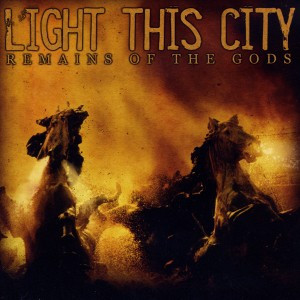 It was with their second record that Light This City really began to shine, melding their Bay Area Thrash roots with their more wide-ranging Gothenburg influences in a much more convincing, and impressively individual, manner. Laura Nichol’s ferocious, instinctive delivery had found its footing, the band’s compelling front-woman capitalising on her newfound confidence to stretch her limits and push her vocals to new heights of venom and spite.
It was with their second record that Light This City really began to shine, melding their Bay Area Thrash roots with their more wide-ranging Gothenburg influences in a much more convincing, and impressively individual, manner. Laura Nichol’s ferocious, instinctive delivery had found its footing, the band’s compelling front-woman capitalising on her newfound confidence to stretch her limits and push her vocals to new heights of venom and spite.
The simmering, slow build introduction of “Remains Of The Gods” reaches boiling point with the aggressive, tumultuous drums and punishing chugging that kick in part way through, the group singling out moments of sparse, fragile melody amidst the sawing, thrashing riffs of Ben Murray and threatening barks of Laura Nichol, whilst bassist Ben Dias makes his presence felt through a series of rumbling accoutrements which give the track a deeper and stronger bottom end.
Thrashy tempos and buzz-saw guitars abound throughout “Obituary”, a more rhythmically varied and technically adept number that showcases the seamless interlocking of Murray’s powerful drums and Dias’ rumbling bass lines, along with the sharp and deft finger work that conjures up each switchblade guitar line. Mid-way through, the song switches up gears from a grinding thrash motif to a more balls-out melodeath attack, which steadily increases in velocity before crashing to halt in a conjunction of twisted metal and agonised screams.
The taut and contorted structure of “A Guardian In A Passerby” sees the band crafting the first of many songs which begin to to capture the electric and eclectic dynamism which would feed into their subsequent works, executing deep and impressive riffs that match majestic melody with propulsive power and blackened brutality. Following this, “The Hunt” is possessed of a malevolent groove, brooding with an undercurrent of barely suppressed violence. This powder-keg explodes when the band kicks the chair out and falls headlong into a torrent of bruising, staccato chugs and wildy weaving guitar lines, underpinned by a prominent and clanging bass performance.
The second half of the record is arguably even stronger than the first. After the initial shock at how strong the band’s material has become in the intervening years between this, their second album, and their scrappier first effort, has worn off, one can appreciate the manner in which the group have condensed and bottled their vigorous live energy and intensity for the recorded experience. The compositional skills of the group have improved ten-fold as well, each song broader in sound and scope, yet equally more focussed and tightly written, flowing between styles without hesitating or stumbling.
The souped-up, Iron Maiden on steroids vibe of “Fractured By The Fall” sees the band exercising their melodic muscle to its greatest effect, unashamedly pilfering classic melody lines in order to twist them into new shapes, bolting them onto a chassis of jagged, scraping riffage, welded together by Ben Murray’s flourishing, fluid stock work. Throughout the song, a series of crystalline, piercing melodies thrust upward through the cracks in the scorched-earth guitar work, providing prominent towers of light balanced out by the bouncy, exuberant drums and reverberant bass lines.
Screaming into view at full pelt, the unceasing, artillery-fire kick-drumming of “The Static Masses” rumbles menacingly beneath the grinding, lurching guitars to give the song a more focussed, death metal intensity over which Nichol’s throaty, gravelly vocals dominate proceedings with overwhelming force and madcap fervour, the song’s dark and death metal leanings providing a perfect contrast to the combustive, guitar-driven storm of “Guiding The North Star”, a remarkably direct and linear song that never lets listeners have a moment to catch their breath, delivering endless torrents of shining leads and sharpened tremolo guitars in its tightly compressed running time.
Following a blistering, blast-beat laden intro, “Your Devoted Victim” settles into a rapid-fire groove of primal thrash-beats and fret-blazing finger-work whose speedy, serpentine grace recalls prime Exodus as seen through a fractured, deathly prism. The band sink their teeth into the song’s catchy, propulsive chorus with gleeful abandon, after which the second half of the track passes by in a blur of whirlwind guitars and cataclysmic drumming fury, leading into the album’s melancholic instrumental outro.
Sample Song: “Obituary”
[audio:https://www.nocleansinging.com/wp-content/uploads/2011/08/02-Obituary.mp3|titles=Light This City – Obituary]Facing The Thousand – 2006
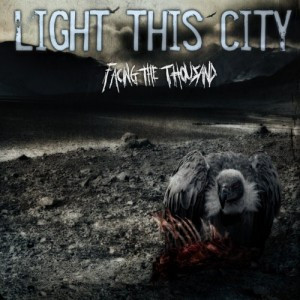 I truly consider this album an undiscovered jewel in the crown of American metal, a truly singular piece of work that wears its influences on its sleeve but uses them to craft something wholly distinctive and individual. It’s an album I come back to time and time again to get my pulse racing and my limbs moving.
I truly consider this album an undiscovered jewel in the crown of American metal, a truly singular piece of work that wears its influences on its sleeve but uses them to craft something wholly distinctive and individual. It’s an album I come back to time and time again to get my pulse racing and my limbs moving.
The epic introduction of “Facing The Thousand” builds from a martial, marching, symphonic beginning to a crescendo of storming, thunderous guitars. Through a subtle intelligence of composition, the song, from start to finish, keyboards to guitars, maintains a central melody line throughout its ripping tremolo sections and powerful chord progressions that ties the whole experience together without ever becoming repetitive. It’s a clever trick and one that takes several listens in which to unpeel the layers. The guitar tone is punchy and aggressive, while the drums hit with concussive force, tempered by the thrumming, reverberating bass lines which rumble with oceanic swells of power beneath it all.
The song’s single (with video-clip to boot), “The Unwelcome Saviour”, is a prime showcase for the band’s aggressively charged take on melodeath dynamics fuelled by limber, blast-driven drumming and lithe, sweepingly melodious string work. Ben Murray’s drums and Laura Nichol’s vocals battle for supremacy throughout, shifting styles and approaches as the song dictates, Murray’s seamless, shifting blast-beats and skittering rolls vying with Nichol’s paint-stripping delivery for the listener’s attention, before the twin guitars of Brian Forbes and Steve Hoffman leap back into the fray, reminding you that this is, first and foremost, a guitar-led band.
“Exile” toys with expectations somewhat, providing a more measured take on The Black Dahlia Murder’s own brand of spiny riff explosions and sand-blasting drums. At unexpected points the band drop in a more overtly melodic and heroic lead refrain, or shift their tempo down to a more considered pace, allowing breathing room amidst the stunningly fast and tumultuous drums and warp-speed riffing that make up the majority of the track. Despite his status as an under-rated, under-appreciated, and indeed practically unknown member of the metal community, drummer Ben Murray is actually able to make his kit sing with his playing style, delivering a truly striking variety of beats, fills and brutal bludgeonings that reverberate with individuality and nuance.
More so than any of their other releases, this album demonstrates a key influence from Heartwork-era Carcass, nimbly shifting speed and intensity between powerful thrash-beats and scathing blast-beats to accent the scything melodic riffage. Case in point, “Maddening Swarm” straddles the At The Gates/Carcass divide in order to draw on the precision melodicisms of the former and the controlled, chaotic energy of the latter in a manner that few have dared attempt, and even fewer have actually succeeded in harnessing effectively.
“City Of Snares” has a vibrant, punkish energy to it, snapping wildly with relentless piercing snare hits, choking, garrotting tremolo guitars and Laura Nichol’s rabid snarls and ominous growl, taking the band’s melo-death based sound in a slightly different direction, which contrasts well with a song like “Fear Of Heights”, which features vocal contributions from The Black Dahlia Murder’s Trevor Strnad. Unleashing a bubbling torrent of bile and hatred, there’s a point in the song where Strnad hits his most gurgling low, while Nichol simultaneously unleashes her most ear-piercing shriek, that sounds like madness itself unleashed, if only for a fleeting moment.
Following on from this monstrous, pugnacious death metal beast, the band continue to explore these darker themes in the primal brutality of “Tracks Of Decay”, which sees the group unleashing musical barbarism at a horrendous pace, yet off-setting this with diversions into clear, ascending guitar-driven melody and sweeping moments of resonant clarity, which pierce the darker pall of the song to great effect.
The album ends, fittingly with “Like Every Song’s Our Last”, which distills the drive and energy of the album down into a concise and focussed, sub-3 minute display of firebrand vocals, pummelling, galloping guitars and whip-crack drums. It ends the record on a high note, not a riff or beat out of place, pounding toward its climax with unrelenting passion and fury.
Sample Song: “The Unwelcome Saviour”
[audio:https://www.nocleansinging.com/wp-content/uploads/2011/08/03-The-Unwelcome-Savior.mp3|titles=Light This City – The Unwelcome Savior]Stormchaser – 2008
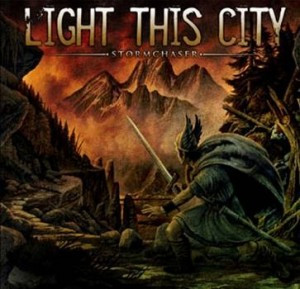 Thrashier and less sharply focussed than their previous album, the group’s swansong displays less of the primal death metal influences and a more thrash-focussed twin guitar attack, without skimping on the shining melo-death dynamics. There’s a greater focus on shredding solo work on this record than the band have displayed before, as well as a greater prevalence of restraint and dynamic, teasing moments of classy acoustic guitar and haunting keys showing the band painting with a broader palette than before.
Thrashier and less sharply focussed than their previous album, the group’s swansong displays less of the primal death metal influences and a more thrash-focussed twin guitar attack, without skimping on the shining melo-death dynamics. There’s a greater focus on shredding solo work on this record than the band have displayed before, as well as a greater prevalence of restraint and dynamic, teasing moments of classy acoustic guitar and haunting keys showing the band painting with a broader palette than before.
“Stormchaser” opens the album with rumbling thunder and slowly building intensity that detonates into a series of spiky thrash riffs and hard-hitting drum beats. For a long time the track avoids the more overt, epic melodies of their previous albums, blasting through more fractious arrangements of riffs, deferring the more obvious pleasures of slickly melodic lead parts until later in the song, where it takes on a more measured and reflective pace.
“Fragile Heroes” wears its death metal influence loudly and proudly, tempered by dark lead guitar melodies and dissonant anti-harmonies. Ms Nichol unleashes her sparingly used gutturals to great effect on this track, while drummer Ben Murray reigns in the contradictory chaos with an impeccably tight performance of rolling fills and precise blast beats.
“The Anhedonia Epidemic” and “Beginning With Release” really kick the album into a higher gear, blazing a trail with prominent melodies and infectious, energetic riffage which demand a response from the listener. The former’s gloriously catchy lead refrains and frantic, post-In Flames riffs are welded onto a punky, stop-start dynamic without losing any of their metallic fervour, while the latter’s soaring melodies are matched with a heightened sense of aggression and a crunchy collision of barbed riffs and throat-scraping screams. Pulsing with barely repressed energy, the song simply seems to get more intense as it progresses, the band throwing caution to the wind and delivering a fiery array of riffs and beats, culminating in a massive, shredding solo.
Further hammering home the thought that Light This City’s demise was particularly untimely, the songs “Firehaven” and “The Collector Part 2: Donor” featured appearances from guest vocalists that perfectly mirrored the position the band were in before their end. Thrash metal’s man-mountain himself, Chuck Billy (Testament), brings his belligerent bark to “Firehaven”, adding both credibility and infamy to the band’s sound and increasing their exposure to the metal mainstream, while “The Collector Part 2: Donor” features The Funeral Pyre’s John Strachan, whose snarling delivery giving the track a vicious, blackened edge that renews the band’s ties to the underground that birthed them.
The latter half of the album maintains the high quality of the first half with a series of impeccably written and impressively performed tunes that never skimp on the guitar pyrotechnics or death metal fury. “A Desperate Resolution” suitably captures a desperate, frenzied vibe with its speedy, calamitous staccato riffage and weaving lead guitars, refusing to be pinned down to one particular style or form as the song rampages unceasingly onwards, driven to its climactic conclusion by Murray’s unflinching barrage of blast-beats and scatter-shot fills.
“Wake Me At Sunset” has the most melodic and, dare I say it, epic vibe on the record. The band use their scalpel-sharp riffs and galloping tempos to tell a story of love and loss that bleeds emotion and integrity. The razor-edged, twin guitar playing of Messrs. Forbes and Hansen shines brightest on this track, delivering a blistering array of riffs and leads that are a guitar fanatic’s wet dream.
Concluding with the stunning pairing of “Sand And Snow” (short and speedy but with a steady, stomping conclusion of restrained guitars and a soaring, bluesy solo) and “Self Portrait” (crushingly heavy and dark, with an unstoppable, intense drumming performance), the album has, for me, a wistful melancholy about it now, being the last recorded output of the band who broke up just before its release, leaving so much untapped potential still unrevealed. Both songs are electric and captivating compositions that bristle with untamed aggression and a ferocious desire, at least providing a fitting epitaph and final statement for the band.
Sample Song: “Wake Me At Sunset”
[audio:https://www.nocleansinging.com/wp-content/uploads/2011/08/09-Wake-Me-At-Sunset.mp3|titles=Light This City – Wake Me At Sunset]Recommended For Fans Of: Darkest Hour, The Black Dahlia Murder, Nightrage

Forgive me for only skimming and checking out the tunes so far. I’ll give this a proper read later on when I get back from work.
One thing that sticks out with “Wake Me At Sunset” are the Maiden-esque leads. That alone is enough to make me want to spend the time reading your writeup, listening to the other songs and determining where Light This City goes on the to get list if they go there. One song’s not enough to make up my mind, but it is enough to tell me that it may be worth considering.
I hope they make the list…
Although if it’s anything like MY “To Get” list then you may not have any space left on it…
Andy, I cannot tell you how unbelieveably stoked I am to see such a comprehensive discussion of a supremely talented and one of my absolute favorite bands (and I usually hate track by track reviews.)This is my “personal hidden gem” band that I really felt like no one but me knew about, especially after their demise.
Sometimes in art/entertainment you get to have your cake and eat it too; an intellectually stimulating or thought provoking experience that also brings viceral, tangible, big time bang for your buck immediate joy and satisfaction. Like the movies Ronin or Aliens, musically Light This City is the total fucking package. Whether it be the dynamic compisitons, technical prowess, the distinct point of vew the lyrics brought, or the balls out smashing brutatlity of the tracks, this band delivered. I never got to see, but I hear there live show destroyed as well.
Ive rocked their catalog whole focusing on powerlifts in the gym, blasted it at major ragers, and submersed myself in a dark room and headphones while drowning in alchohol and deep thought. I emplore anyone not familiar with Light This City to track down there complete discography, especialy If you are particularly fond of melodic death metal (hell, if you’re fond of metal at all for that matter).This is what it’s all about.
I didn’t read some of this article, or all it’s responses as I usually just skip right to the music. BUT, from what I read, I didn’t notice anyone mention the punk band, “Heartsounds,” that rose out of the ashes of Light This City. It features the girl vocalist and one of LTC’s guitarists. Heartsounds aren’t metal, but if you’re into Bad Religion style punk, with little bits of speed metal tossed in for good measure, they’re worth checking out. I like them a heck of a lot more than I ever did Light This City. And as a side not, I met the front woman several years back when these guys opened for Testament. She is even hotter in person!